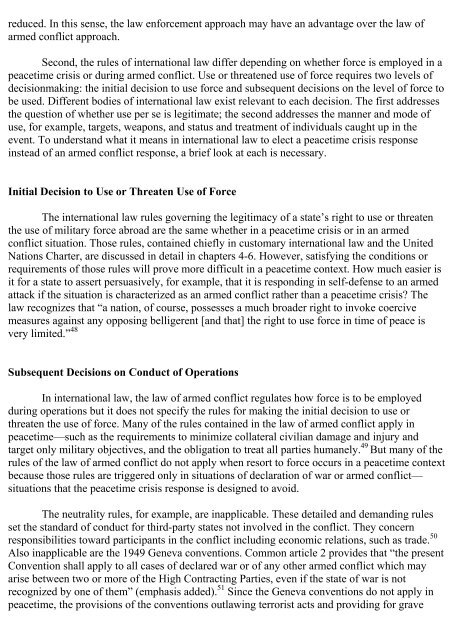Legitimate use of military force against state-sponsored - Air University
Legitimate use of military force against state-sponsored - Air University
Legitimate use of military force against state-sponsored - Air University
You also want an ePaper? Increase the reach of your titles
YUMPU automatically turns print PDFs into web optimized ePapers that Google loves.
educed. In this sense, the law en<strong>force</strong>ment approach may have an advantage over the law <strong>of</strong><br />
armed conflict approach.<br />
Second, the rules <strong>of</strong> international law differ depending on whether <strong>force</strong> is employed in a<br />
peacetime crisis or during armed conflict. Use or threatened <strong>use</strong> <strong>of</strong> <strong>force</strong> requires two levels <strong>of</strong><br />
decisionmaking: the initial decision to <strong>use</strong> <strong>force</strong> and subsequent decisions on the level <strong>of</strong> <strong>force</strong> to<br />
be <strong>use</strong>d. Different bodies <strong>of</strong> international law exist relevant to each decision. The first addresses<br />
the question <strong>of</strong> whether <strong>use</strong> per se is legitimate; the second addresses the manner and mode <strong>of</strong><br />
<strong>use</strong>, for example, targets, weapons, and status and treatment <strong>of</strong> individuals caught up in the<br />
event. To understand what it means in international law to elect a peacetime crisis response<br />
instead <strong>of</strong> an armed conflict response, a brief look at each is necessary.<br />
Initial Decision to Use or Threaten Use <strong>of</strong> Force<br />
The international law rules governing the legitimacy <strong>of</strong> a <strong>state</strong>’s right to <strong>use</strong> or threaten<br />
the <strong>use</strong> <strong>of</strong> <strong>military</strong> <strong>force</strong> abroad are the same whether in a peacetime crisis or in an armed<br />
conflict situation. Those rules, contained chiefly in customary international law and the United<br />
Nations Charter, are discussed in detail in chapters 4-6. However, satisfying the conditions or<br />
requirements <strong>of</strong> those rules will prove more difficult in a peacetime context. How much easier is<br />
it for a <strong>state</strong> to assert persuasively, for example, that it is responding in self-defense to an armed<br />
attack if the situation is characterized as an armed conflict rather than a peacetime crisis? The<br />
law recognizes that “a nation, <strong>of</strong> course, possesses a much broader right to invoke coercive<br />
measures <strong>against</strong> any opposing belligerent [and that] the right to <strong>use</strong> <strong>force</strong> in time <strong>of</strong> peace is<br />
very limited.” 48<br />
Subsequent Decisions on Conduct <strong>of</strong> Operations<br />
In international law, the law <strong>of</strong> armed conflict regulates how <strong>force</strong> is to be employed<br />
during operations but it does not specify the rules for making the initial decision to <strong>use</strong> or<br />
threaten the <strong>use</strong> <strong>of</strong> <strong>force</strong>. Many <strong>of</strong> the rules contained in the law <strong>of</strong> armed conflict apply in<br />
peacetime—such as the requirements to minimize collateral civilian damage and injury and<br />
target only <strong>military</strong> objectives, and the obligation to treat all parties humanely. 49 But many <strong>of</strong> the<br />
rules <strong>of</strong> the law <strong>of</strong> armed conflict do not apply when resort to <strong>force</strong> occurs in a peacetime context<br />
beca<strong>use</strong> those rules are triggered only in situations <strong>of</strong> declaration <strong>of</strong> war or armed conflict—<br />
situations that the peacetime crisis response is designed to avoid.<br />
The neutrality rules, for example, are inapplicable. These detailed and demanding rules<br />
set the standard <strong>of</strong> conduct for third-party <strong>state</strong>s not involved in the conflict. They concern<br />
responsibilities toward participants in the conflict including economic relations, such as trade. 50<br />
Also inapplicable are the 1949 Geneva conventions. Common article 2 provides that “the present<br />
Convention shall apply to all cases <strong>of</strong> declared war or <strong>of</strong> any other armed conflict which may<br />
arise between two or more <strong>of</strong> the High Contracting Parties, even if the <strong>state</strong> <strong>of</strong> war is not<br />
recognized by one <strong>of</strong> them” (emphasis added). 51 Since the Geneva conventions do not apply in<br />
peacetime, the provisions <strong>of</strong> the conventions outlawing terrorist acts and providing for grave
















